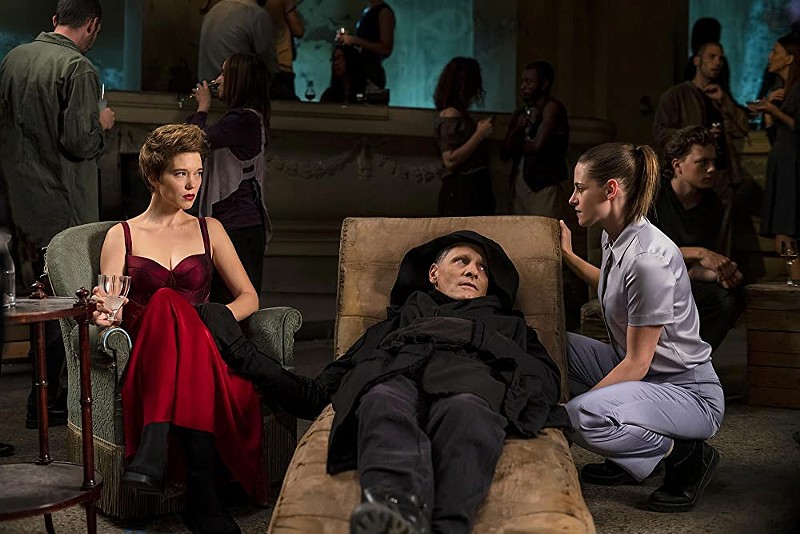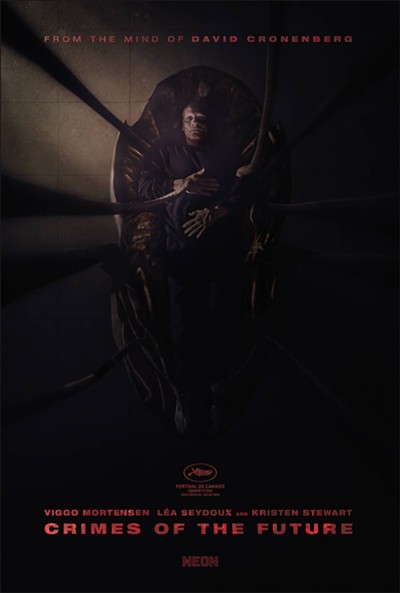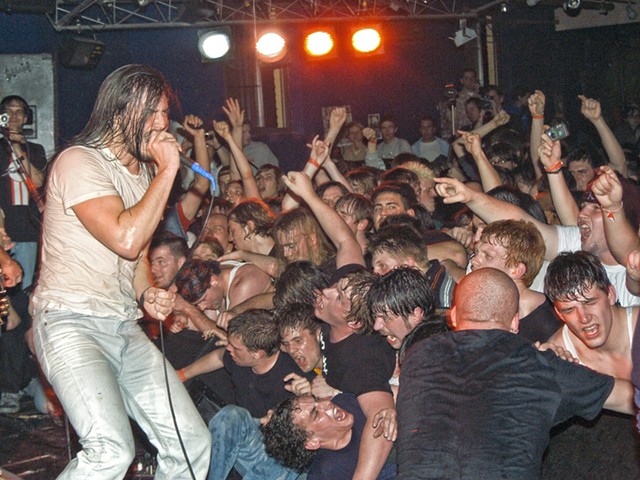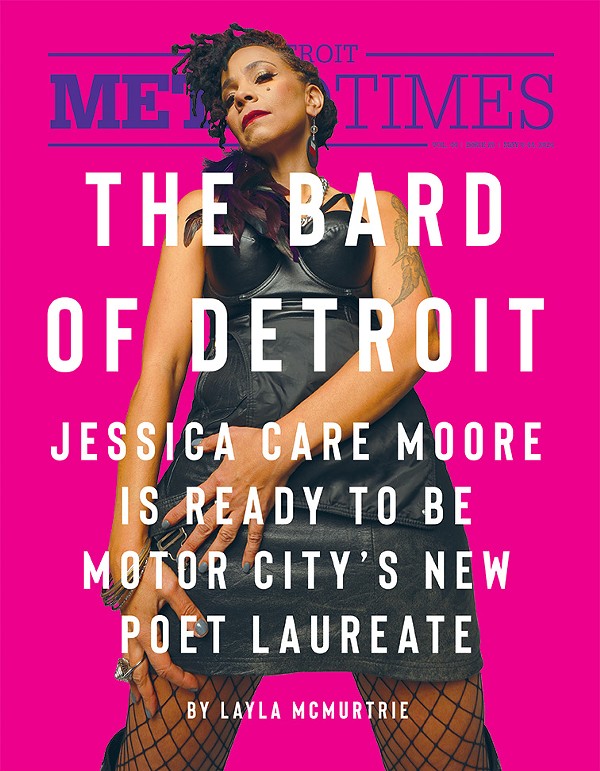Playful, wry, and perversely optimistic, the latest from David Cronenberg merges spheres once easier to imagine as discrete, or naturally apart. But what’s “natural” here, as has so often been the case for him, seems fairly beside the point. The 79-year old director of Videodrome and The Fly situates his intimate, small-scaled dystopia in an imminent future where the world’s already been spoiled. Toying with binarized divisions between the public and personal, intimate and violent, and desolate and hopeful, Crimes of the Future responds to but holds little reverence for the society and structures of the world we know.
Shot in a barren, barely-lit Athens, Greece, light on foot traffic but caked in grime, the film’s surreal action unfolds in an unnamed city in which humans have ceased to feel pain. Many, too, have abandoned sex and begun to develop in unexpected ways, whether by accident or by design. Amid this confluence of new normals, surgery has become a new kind of exhibitionist spectacle, with body modification taking center stage in a new field of performance art.
In this new space of the artistic avant-garde, Saul Tenser (a game, wincing Viggo Mortensen) and his eager partner Caprice (Léa Seydoux), a former surgeon, serve as underground celebrities: the king and queen of a warehouse scene. Beneath the gaze of rapt crowds Seydoux excises her prolific partner’s organs in a revived form of surgical theater. Regarded as extraneous yet precious artifacts, they’re celebrated, preserved, and documented accordingly. For many, such penetrative, generative, and violative acts have replaced “the old sex” almost entirely.
Amid this rubble-strewn landscape, fitful efforts at bureaucratic control remain. Saul and Caprice contend, for instance, with the National Organ Registry, which works to constrain and account for directions in human development from the space of a bare-bones office. (Its two investigators, Timlin and Wippet, played by Kristen Stewart and Don McKellar, work with an anxious interest that sprints quickly beyond professionalism). At the same time, Tenser maintains contact with a vice detective (played by a stylish, enigmatic Welket Bungué), convening in alleyways and junkyards. Before long, each figure’s power comes to seem as questionable as their respective sources of authority do. Not a badge nor credential is ever presented, resulting in an essentially feudal dynamic in which control is maintained amid flashes of confluent motives, and via tenuous networks of desire, trust, and questionable word.
This jockeying for power is rounded out by the introduction of a rival figure: a scruffy, flanneled subversive named Lang Dotrice (a terrifically sleazy Scott Speedman), who has his own theories about art and human development. The world of Crimes — in which rebel cells and artistic scenes hold power in ways that rival the administrative state — scans as familiar in its inefficiencies, heartening for its sense of erratic potential, and strangely out of tilt.
This quietly radical instability lies at the heart of Crimes’ unexpected liveliness; loath to cling to safe terrain, Cronenberg benefits from a near-total lack of preciousness. Working from a script now twenty years shelved, his tonal pitch proves queasily comic in its subversions, even for lines that could have been arch or grasping if presented another way. As others have noted, Crimes is a fine product not only of a slim budget of a veteran director’s late style, embracing unresolved contradiction and an aesthetic approach stemming from a combination of unfussiness and skill. At the same time, what it’s doing feels relaxed in effect even as it racks up striking images with its wealth of visual and bodily ideas. By the end, it manages to cultivate a sharp, roiling sense of accumulated dread.
That sensation has many sources, and Cronenberg’s decades of experience aids him in mining every well available to casually excellent effect. (A pervading cleverness, a direct, at times laconic approach to performance of dialogue, and an overriding air of bemusement only heighten the film’s atmosphere by disarming.) Beyond the peripheral sense of the film’s frail power structures, which reek of frantic efforts toward control, containing biological and political instability, there are the centerpiece scenes of surgical theater. Presented with a minimum of gore, the scenes for a clear look at the unnerving spectacle they provide. Each surgical undertaking is performed, too, with an array of insectile and fleshy machinery. These tools pervade Saul and Caprice’s lives so deeply that negotiations with these technologies become, especially for Tenser, a mandate as much as a creative vocation; he depends upon them to survive.
In each figure’s relationship to their own artistic work, Crimes finds its guiding metaphors, toying in what seems a barely-veiled firsthand way with the stakes of producing creative material. Much of the film’s language is occupied with plainspoken discussions of artistic theory and process; a deadpan register that’s long been part of Cronenberg’s aesthetic style. What’s expressed cuts a number of directions; If Mortensen doesn’t remove his new organs, we’re told, they’ll eventually kill him — though there are competing theories. Surgical modifications, some insist, provide a unique way for those to restore a sense either of submission or control, or to adapt to the world around them. In the case of Crimes’ central couple, the power dynamic is productively inverted (as often in Cronenberg’s work), with Seydoux conveying a sense of lush satisfaction in opening and exposing her partner only to tinker with his innards: a near-vengeful expression of her restless creativity.
What distinguishes Crimes most from Cronenberg’s prior, quite forward-looking body horror, though, is that it feels considerably less anxious. When we witness Mortensen’s face contorting with each fresh violation, he seems good-humored, even serene in his discomforts. Whether coughing, struggling to eat, or having his abdomen opened up, there’s a beguiling and even inspiring air of peace to his surrender. As the unmistakable product of an old man’s hand, Crimes of the Future offers a cavalier, musing look at the grim stuff that’s just ahead: a testament less to emotional disinvestment than to some measured, stoic strain of hope.
Film Details
Stay connected with Detroit Metro Times. Subscribe to our newsletters, and follow us on Google News, Apple News, Twitter, Facebook, Instagram, Reddit, or TikTok.







